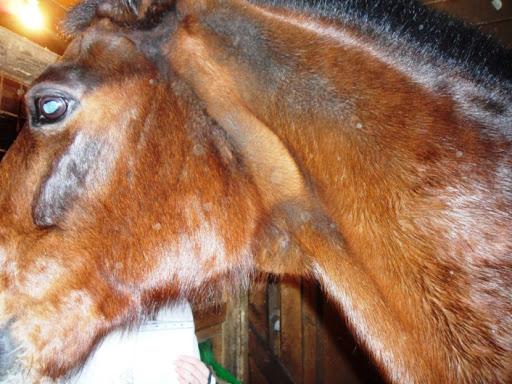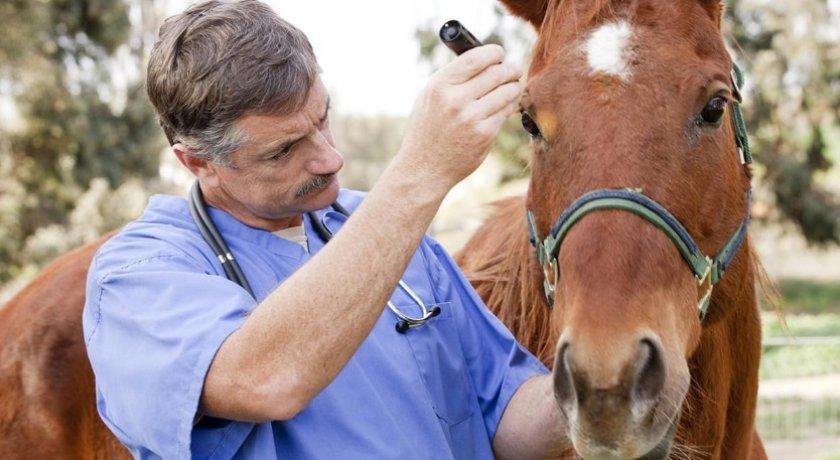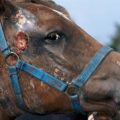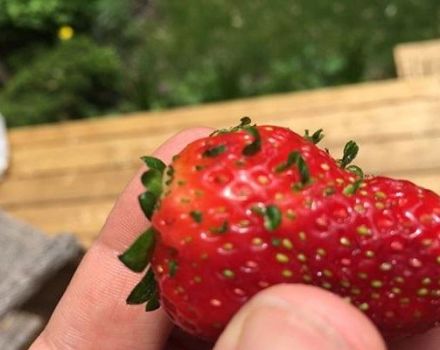The causative agent and symptoms of washing in horses, methods of treatment and methods of prevention
The first mentions of the disease are found in documents of the 16th century. And the infectious nature of horse washing was established in the 18th century. Animal disease has been encountered by farmers and breeders around the world. Fever, high body temperature, purulent lesions of the lymph nodes, inflammation in the pharynx and nasal cavities are the main signs of horse disease.
Description of the disease
Myt belongs to acute infectious diseases (Coryza contagioza equorum). The causative agent is streptococcus. The incubation period is 3-14 days. The blood and lymph of an animal are the pathways for the spread of the pathogen. The disease affects horses everywhere. Young horses (from six months to 5 years old) suffer from the infection. Foals up to 6 months of age do not get sick with washing thanks to the mother's milk, with which they receive immunobodies and complete proteins.
Adults (over 5 years of age) can also become infected, but such cases are rare. Deaths, according to statistics, are rare. However, one must bear in mind the high rate of spread and transience of the disease in horses, which increases the likelihood of the death of a large number of individuals.
Causative agent of infection
Spores do not form in mytaya streptococcus. The causative agent of the disease has the form of a long motionless chain, formed from dozens of individual links, flattened in diameter (04-1 microns long). Long-term preservation in the external environment is characteristic of mytny streptococcus. In rooms with an adobe base, the infection persists for 8-9 months.
Advice! It is necessary to thoroughly wash the premises from purulent discharge from the wounds of horses, since in a dry pus infection remains viable for 11-12 months. It is difficult to neutralize with disinfectant solutions.
Streptococci live on straw, hay, horse hair for 20-22 days. The causative agent of the disease is sensitive to sunlight (they die after 7-8 days). When the surface is heated, streptococcus dies after 50-60 minutes, and in case of boiling, instantly.

Reasons for the appearance and habitat
Sick animals are not the only sources of infection. Even horses that have been ill or healthy horses carrying bacteria are dangerous. The spread of the disease washes by airborne droplets due to direct contacts between animals (touching, sniffing). Indirect contact is a common way of spreading infection. Streptococcus habitat: feed and feeders, water and water tanks, surfaces of stables, in which sick horses were kept.
There are several factors that provoke the appearance of myt:
- long transportation of horses in poor conditions;
- animals are kept in inappropriate premises;
- lingering cold;
- sharp fluctuations in temperature during rainy periods.
Most often horses are affected by myt, which are bred in areas with cold and temperate climates. During the year, outbreaks of the disease are observed most often in such periods: late autumn, winter and early spring. Inadequate nutrition of animals during a drought also contributes to a decrease in immunity.

The course of the disease and its symptoms
Most often, the disease develops and passes in an acute form. Blood and lymph spreads streptococcus throughout the animal's body. The incubation period can be from 3 to 14 days. There are two types of disease progression.
Typical form
A typical horse wash is characterized by fever, an increase in body temperature up to 41 ° C. The animal has a decrease in appetite, a depressed and lethargic state. The first symptoms are inflammation in the pharynx, problems with swallowing food and water appear. It happens that the water is not swallowed, but pours out through the nostrils. Rhinitis manifests itself as a purulent discharge from the nasal cavity. On palpation, the lymph nodes under the jaw are palpated.
The inflammatory process in the lymph nodes lasts for several days, and the edema begins to spread to the parotid region, the lower edges of the cheeks.
When the abscess breaks open, thick pus begins to flow. The outflow of pus after a while decreases, the body temperature is normalized. During the period of illness, urine excretion is reduced, and in the process of recovery, the volume of urine increases. A typical wash lasts 14-20 days.

Atypical myt
In this case, the disease in horses is mild or severe. For an abortive (light) wash, slight enlargements of the lymph nodes under the jaw, an inflammatory process in the nasal cavity are characteristic. Symptoms of the disease: cough, loss of appetite, depression, fever. The infectious disease lasts for about a week.
The disease in a metastatic form is difficult - the animal has enlarged lymph nodes in the chest and abdominal cavities. Sometimes there is purulent inflammation of the joints. In the case of severe inflammation of the parotid gland nodes, pus enters the larynx, lungs, contributing to the development of bronchopneumonia. In the future, edema of many parts of the body (legs, abdomen, dewlap) is observed.
It is impossible to foresee the development of the disease. Sometimes animals recover after one to two weeks. And sometimes the rapid spread of infection leads to the death of the animal after 3-5 days due to laryngeal edema.
Complications that are observed after washing are also dangerous: suffocation, petechial fever. It must be admitted that signs of fever may appear in a small number of horses that have had myt (literally 1-2%). Symptoms of the disease: swelling is formed on the mucous membranes of the nasopharynx, on the legs, and the scrotum. On the mucous membrane of the new cavity, hemorrhages appear in the form of dots, gradually turning into spots or stripes. Swelling of various parts of the body is observed.

Disease detection methods
Mytitis streptococcus is found in horses in nasal discharge and unopened abscesses. Laboratory studies of secretions, the clinical picture of the course of the disease, pathological data are used to make a diagnosis.
With damage to the lymphatic system, inflammation of the lymph nodes is observed, which is felt on palpation. With strong suppuration, areas with abscesses are opened. The animal's temperature rises, which does not subside, the appetite disappears, and severe exhaustion is observed.
Treatment and Precautions
Myth infection is fought with local and general treatment. The general use of antibiotics is. To find an effective medicine, be sure to check the sensitivity of streptococcus. Antibiotics from a number of cephalosporins are usually used. Alternatively, intramuscular injections of bicillin are prescribed (one injection per day is given for 3-4 days).

In severe cases (metastatic myt), intravenous administration of alcohol 33%, diluted with glucose 20-30% with the addition of norsulfazole 1%, is prescribed. Caffeine or camphor is given intramuscularly if cardiac impairment is present. The volume of water for drinking is limited, while hydrochloric acid is added to the water (8-10 ml are diluted in a bucket of water). It is recommended to do a light massage of the swollen areas. If there is a threat of suffocation, a tracheotomy is done.
To accelerate the maturation of abscesses in the lymph nodes, a special ointment is rubbed into the skin - serortute. The processed skin areas are pre-prepared - hair is cut off, the skin is degreased. After gently rubbing in the ointment, it is advisable to apply a warming dry bandage to the treated area of the body.
Important! Ripe abscesses must be opened.
The wound is cleansed of pus, dead skin. With the help of a weak solution of potassium permanganate, the cavity to be treated is washed. The edges of the cavity are lubricated with iodine solution. If the wound heals normally, there is no need to regularly flush the cavity. The site is treated dry.
In order to prevent the onset and spread of the disease, new horses are kept in quarantine for about 30 days. When the first symptoms of washing appear, all horses are visually examined and the temperature is measured. Sick individuals are isolated and treated.

To prevent the spread of infection, all animals are provided with individual pens, feeders and drinkers. The stables must be cleaned and sprayed with a special disinfectant solution. In the premises, the floor, walls, feeders, buckets, animal care items are treated. Recovered horses are also wiped with disinfectants.
How to prevent myt infection
The main goal of preventive measures is to increase the resistance of the equine organism to infection. For this, foals over six months old are provided with nutritious food and good maintenance. The stables are kept clean - they regularly wash the pens, remove the dirty straw.
In the summer, you need to graze the animals on pastures for longer. At the same time, reliable sheds must be installed in the grazing area so that the horses can take shelter from the weather. Upon admission, new individuals are carefully examined, their body temperature is measured. When suspicious symptoms appear, diseased individuals are isolated.
Do not underestimate even isolated and mild cases of myta in horses, since the infection causes significant harm to animals. Foals have temporary developmental disabilities. And adult horses lose their ability to work. Therefore, it is recommended to constantly carry out preventive measures.









